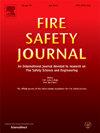Transient horizontal flame spread under non-steady concurrent airflow
IF 3.4
3区 工程技术
Q2 ENGINEERING, CIVIL
引用次数: 0
Abstract
The transient horizontal flame spread over thin black cast polymethyl methacrylate (PMMA) sheets under non-steady airflow profiles is examined experimentally. The horizontal flame spread behavior is examined through measurements of the pyrolysis front progression and the heated length (measured as the flame extension length) ahead of the pyrolysis front. The magnitude and frequency of the heated length were found to change directly with the frequency and magnitude of the transient component of the non-steady airflow. The transient response of the flame spread rate was less direct, but peak instantaneous flame spread rate values were three to six times greater than the time-averaged values. The presence of a non-steady inlet flow component was found to result in time-averaged flame spread rates up to 20% higher compared to steady-flow cases without the non-steady airflow component. Dimensional analysis with the Richardson number is performed to characterize the importance of natural convection and forced convection. Nearly all cases are found to be in mixed convection regime with some cases in natural convection regime for a portion of the flow profile. An empirical correlation, involving the Richardson number, is used to compare the flame spread rate by accounting for the heat transfer to the unburned fuel. Similar trends are observed between the measured and predicted flame spread rates. The results indicate that the more pronounced transient flame spread rate observed under oscillatory flow, compared to steady flow, can be understood by analyzing the convection regime.
非定常同步气流作用下火焰的瞬态水平传播
实验研究了非稳态气流剖面下黑色铸型聚甲基丙烯酸甲酯(PMMA)薄板上的瞬态水平火焰蔓延。通过测量热解锋面级数和热解锋面前的加热长度(以火焰延伸长度测量)来考察火焰的水平传播行为。加热长度的大小和频率与非稳态气流瞬态分量的频率和大小直接相关。火焰蔓延速度的瞬态响应不太直接,但火焰蔓延速度的峰值是时间平均值的3 ~ 6倍。研究发现,与没有非稳定气流成分的稳定流动情况相比,非稳定进口气流成分的存在导致时间平均火焰蔓延率高出20%。用理查德森数进行量纲分析,以表征自然对流和强迫对流的重要性。几乎所有的情况下都是混合对流,有些情况下是部分流型的自然对流。一个经验相关,包括理查德森数,被用来比较火焰蔓延率,通过计算热量传递到未燃烧的燃料。在测量的火焰蔓延速率和预测的火焰蔓延速率之间观察到类似的趋势。结果表明,振荡流动条件下火焰的瞬态蔓延速度比稳定流动条件下火焰的瞬态蔓延速度要明显得多,这可以通过对流形式的分析来解释。
本文章由计算机程序翻译,如有差异,请以英文原文为准。
求助全文
约1分钟内获得全文
求助全文
来源期刊

Fire Safety Journal
工程技术-材料科学:综合
CiteScore
5.70
自引率
9.70%
发文量
153
审稿时长
60 days
期刊介绍:
Fire Safety Journal is the leading publication dealing with all aspects of fire safety engineering. Its scope is purposefully wide, as it is deemed important to encourage papers from all sources within this multidisciplinary subject, thus providing a forum for its further development as a distinct engineering discipline. This is an essential step towards gaining a status equal to that enjoyed by the other engineering disciplines.
 求助内容:
求助内容: 应助结果提醒方式:
应助结果提醒方式:


